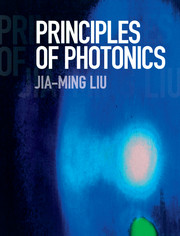Book contents
- Frontmatter
- Dedication
- Contents
- Preface
- Partial List of Symbols
- 1 Basic Concepts of Optical Fields
- 2 Optical Properties of Materials
- 3 Optical Wave Propagation
- 4 Optical Coupling
- 5 Optical Interference
- 6 Optical Resonance
- 7 Optical Absorption and Emission
- 8 Optical Amplification
- 9 Laser Oscillation
- 10 Optical Modulation
- 11 Photodetection
- Appendix A Symbols and Notations
- Appendix B SI Metric System
- Appendix C Fundamental Physical Constants
- Appendix D Fourier-Transform Relations
- Index
- References
11 - Photodetection
Published online by Cambridge University Press: 05 August 2016
- Frontmatter
- Dedication
- Contents
- Preface
- Partial List of Symbols
- 1 Basic Concepts of Optical Fields
- 2 Optical Properties of Materials
- 3 Optical Wave Propagation
- 4 Optical Coupling
- 5 Optical Interference
- 6 Optical Resonance
- 7 Optical Absorption and Emission
- 8 Optical Amplification
- 9 Laser Oscillation
- 10 Optical Modulation
- 11 Photodetection
- Appendix A Symbols and Notations
- Appendix B SI Metric System
- Appendix C Fundamental Physical Constants
- Appendix D Fourier-Transform Relations
- Index
- References
Summary
PHYSICAL PRINCIPLES OF PHOTODETECTION
Photodetection converts an optical signal into a signal of another form. Most photodetectors convert optical signals into electrical signals that can be further processed or stored. All photodetectors are square-law detectors that respond to the power or intensity, rather than the field amplitude, of an optical signal. The electrical signal generated by an optical signal is either a photocurrent or a photovoltage that is proportional to the power of the optical signal. Based on the difference in the conversion mechanisms, there are two classes of photodetectors: photon detectors and thermal detectors. Photon detectors are quantum detectors based on the photoelectric effect, which converts a photon into an emitted electron or an electron–hole pair; a photon detector responds to the number of photons absorbed by the detector. Thermal detectors are based on the photothermal effect, which converts optical energy into heat; a thermal detector responds to the optical energy, rather than the number of photons, absorbed by the detector. Because of this fundamental difference, the general characteristics of these two classes of photodetectors have a number of important differences.
The response of a photon detector is a function of the optical wavelength with a long-wavelength cutoff, whereas that of a thermal detector is wavelength independent. A photon detector can be much more responsive than a thermal detector in a particular spectral region, which typically falls somewhere within the range from the near ultraviolet to the near infrared. By comparison, a thermal detector normally covers a wide spectral range from the deep ultraviolet to the far infrared with a nearly constant response. Photon detectors can be made extremely sensitive. Some of them have a photon-counting capability that is not possible for a thermal detector. A photon detector can be designed to have a high response speed capable of following very fast optical signals. Most thermal detectors are relatively slow in response because the speed of a thermal detector is limited by thermalization through heat diffusion and by heat dissipation when the power of an optical signal varies. For these reasons, photon detectors are suitable for detecting optical signals in photonic systems, whereas thermal detectors are most often used for optical power measurement or infrared imaging. In this chapter, only the basic principles of photon detectors are discussed because our major concern is photodetection for photonics applications.
- Type
- Chapter
- Information
- Principles of Photonics , pp. 362 - 395Publisher: Cambridge University PressPrint publication year: 2016
References
- 5
- Cited by

